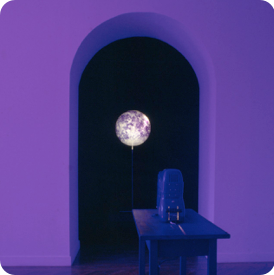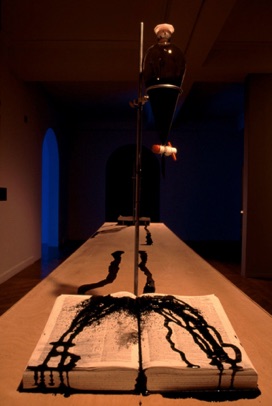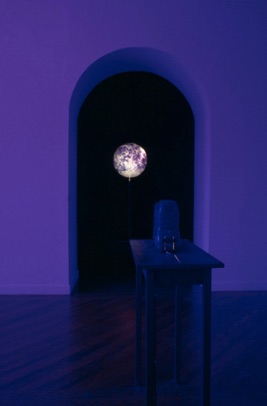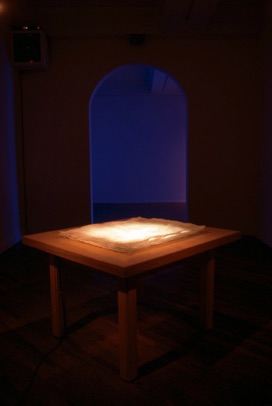INSTALLATION SAN JOSE MUSEUM OF ART, 1991 CATALOG
AS “SONGS OF MENIL” AT CHRISTOPHER GRIMES GALLERY, SANTA MONICA, 1992
“Song of Menil” Sculpture in “Double Trouble,” Museum of Contemporary Art, San Diego, 1999
“Double Trouble” tours in Mexico and Spain, 1999-2001.
PÉ TÚKMIYAT, PÉ TÚKMIYAT is a five room installation that chronicles some of the images contained within the myth of creation in Cahuilla oral literature. A development from the Language of Paradise installation, PÉ TÚKMIYAT, PÉ TÚKMIYAT is an expansion of various key moments within the myth. “PÉ TÚKMIYAT, PÉ TÚKMIYAT” refer to the words, “Darkness, darkness” the first condition of existence at the beginning of things.
In the first of five chambers one encounters a 16’ long wooden “library” table upon which are English dictionaries mounted at each end. Suspended from stands over these books are separatory funnels, each dripping a measure of black ink onto the open pages, obliterating the text. Directly linked with this chamber is the second, dark space. Within this space is a mechanical pendulum with a small video monitor attached to the end of the shaft. From the monitor comes the sound and image of fire. This is the place where the creeator-brothers, Múkat and Témayawet were born.

Two more rooms follow. A windowed chamber with the light shifted violet. A lone table and slide projector stands in this room. The projector sends an image into another dark chamber, landing on the blades of a whirling industrial fan. The image of the moon represents the goddess Menil, who taught the people dance and play, but escaped to the sky after the advances of an amorous Múkat.
In the last room is a table upon which are maps. These maps are of the Cahuilla reservation the lands, the same lands the Cahuilla encountered after the long journey after the murder of Múkat, their father. Along this journey, the people learned the birds songs of each region, which they still sing today. The lights within this chamber shift from light to dark; synchronized to this pattern are the recordings of song birds. When the light goes dim, the room is quiet, but the maps glow with an internal light.


